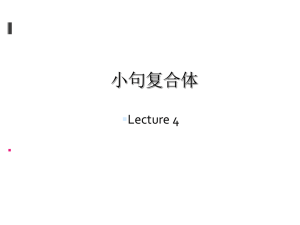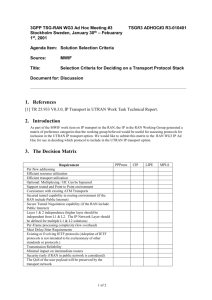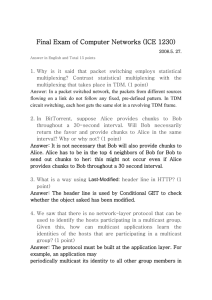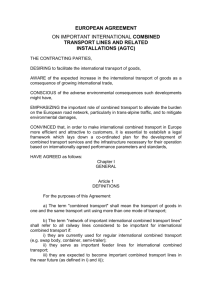t3-99243
advertisement
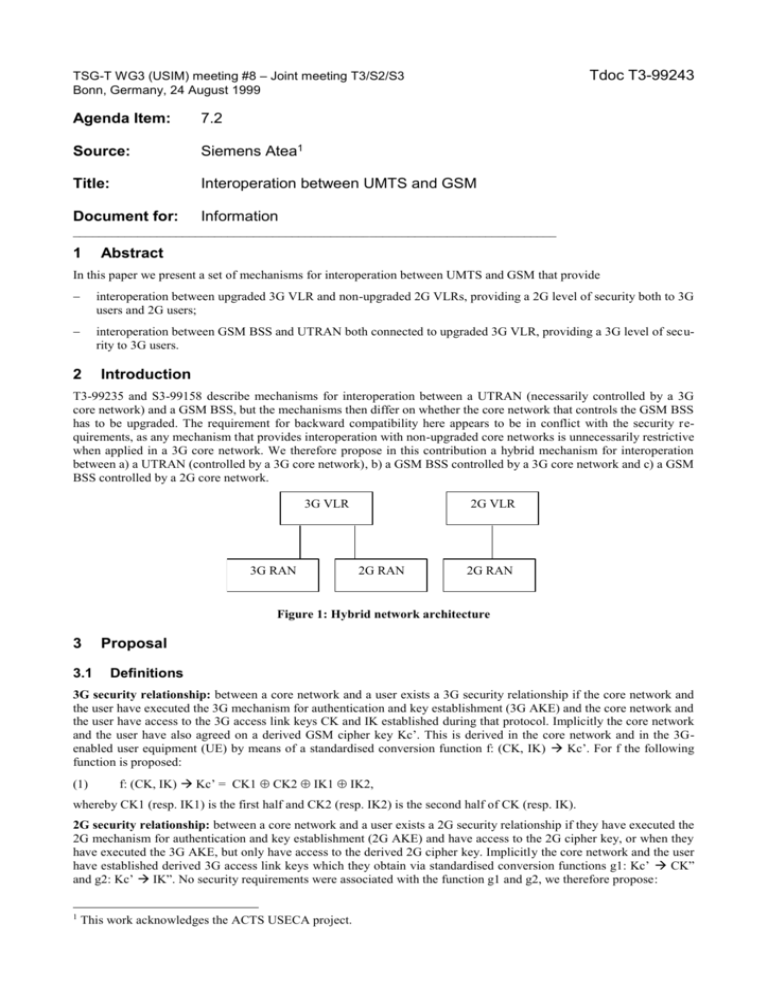
TSG-T WG3 (USIM) meeting #8 – Joint meeting T3/S2/S3 Bonn, Germany, 24 August 1999 Tdoc T3-99243 Agenda Item: 7.2 Source: Siemens Atea1 Title: Interoperation between UMTS and GSM Document for: Information ___________________________________________________________________________ 1 Abstract In this paper we present a set of mechanisms for interoperation between UMTS and GSM that provide interoperation between upgraded 3G VLR and non-upgraded 2G VLRs, providing a 2G level of security both to 3G users and 2G users; interoperation between GSM BSS and UTRAN both connected to upgraded 3G VLR, providing a 3G level of security to 3G users. 2 Introduction T3-99235 and S3-99158 describe mechanisms for interoperation between a UTRAN (necessarily controlled by a 3G core network) and a GSM BSS, but the mechanisms then differ on whether the core network that controls the GSM BSS has to be upgraded. The requirement for backward compatibility here appears to be in conflict with the security requirements, as any mechanism that provides interoperation with non-upgraded core networks is unnecessarily restrictive when applied in a 3G core network. We therefore propose in this contribution a hybrid mechanism for interoperation between a) a UTRAN (controlled by a 3G core network), b) a GSM BSS controlled by a 3G core network and c) a GSM BSS controlled by a 2G core network. 3G VLR 3G RAN 2G VLR 2G RAN 2G RAN Figure 1: Hybrid network architecture 3 3.1 Proposal Definitions 3G security relationship: between a core network and a user exists a 3G security relationship if the core network and the user have executed the 3G mechanism for authentication and key establishment (3G AKE) and the core network and the user have access to the 3G access link keys CK and IK established during that protocol. Implicitly the core network and the user have also agreed on a derived GSM cipher key Kc’. This is derived in the core network and in the 3Genabled user equipment (UE) by means of a standardised conversion function f: (CK, IK) Kc’. For f the following function is proposed: (1) f: (CK, IK) Kc’ = CK1 CK2 IK1 IK2, whereby CK1 (resp. IK1) is the first half and CK2 (resp. IK2) is the second half of CK (resp. IK). 2G security relationship: between a core network and a user exists a 2G security relationship if they have executed the 2G mechanism for authentication and key establishment (2G AKE) and have access to the 2G cipher key, or when they have executed the 3G AKE, but only have access to the derived 2G cipher key. Implicitly the core network and the user have established derived 3G access link keys which they obtain via standardised conversion functions g1: Kc’ CK” and g2: Kc’ IK”. No security requirements were associated with the function g1 and g2, we therefore propose: 1 This work acknowledges the ACTS USECA project. (2) g1: Kc’ CK” = Kc’ || 0..0, (3) g2: Kc’ IK” = Kc’ || Kc’, such that f (g1(Kc’), g2(Kc’)) = Kc’. 2G subscriber/ 3G subscriber: A 2G subscriber is a mobile station equipped with a 2G SIM. Equivalently, a 3G subscriber is a mobile station equipped with a 3G SIM. A 3G SIM has also 2G capability. The GSM functions are then mapped to the UMTS functions in the following way: (4) a3 : RAND SRES = trunc32 ( f2K (RAND) ), (5) a8 : RAND Kc’ = f (f3K (RAND), f4K (RAND) ). 2G user / 3G user: A 3G user is a mobile station that is able to participate in 3G AKE. It necessarily consists of a 3G SIM and a 3G-enabled user equipment. Any other combination of SIM and UE is a 2G user. 2G core network / 3G core network: A 3G core network is an MSC/VLR or an SGSN that can participate in 3G AKE. This requires also that they can receive, store and forward 3G authentication vectors (3G AVS, quintuplets). In addition it is assumed that 3G core networks can also participate in 2G AKE, and equivalently receive, store and forward 2G authentication vectors (2G AVs, triplets) – at least those core networks that provide services to 2G users. On the contrary, a 2G core network is an MSC/VLR or an SGSN that can only participate in 2G AKE. 3.2 Distribution of authentication vectors The 2G HLR sends 2G AVs to all core networks. The 3G HLR sends 3G AVs to 3G core networks and sends 2G AVs to 2G core networks. It derives the 2G AVs from the 3G AVs as specified in (4) and (5). 3.3 Authentication and key establishment A 3G core network and a 3G user execute 3G AKE, all other combinations execute 2G AKE. After 3G AKE (resp. 2G AKE), the user and the core network maintain an 3G (resp. 2G) security relationship. For 3G subscribers with 2G-only user equipment (who are therefore 2G users) that roam into 3G core networks, the 3G core network should be able to derive the 2G AVs from the 3G AVs it receives from the 3G HLR. This is done as specified in (4) and (5). If 2G AKE has been executed and the user is attached to a 3G RAN, the 3G core network and the 3G-enabled UE should use the 3G access link keys, derived as specified in (2) and (3). If 3G AKE has been executed and the user is attached to a 2G RAN, the 3G core network and the 3G-enabled UE should use the 2G cipher key, derived as specified in (1). 3.4 Handover At handover, for users with a 2G security relationship, the 2G access link key is sent over the links between network nodes. If the newly entered radio access network is a 3G RAN, the 3G core network and the 3G-enabled UE derive the appropriate 3G access link keys as specified in (2) and (3) and should use these on the radio access link. At handover, for users with a 3G security relationship to 3G core networks, the 3G access link keys are sent over the links between networks nodes. If the newly entered radio network is a 2G RAN, the 3G core network and the 3Genabled UE derive the appropriate 2G cipher key as specified in (1) and should use that on the radio access link. At handover, for users with a 3G security relationship to 2G core networks, the 3G security association is lost (the user and the core network from now on have a 2G security relationship), and the 2G cipher key is sent over the links between networks nodes, derived as specified in (1). 4 Simplifications for example network configurations In a 3G core network that consist of both 3G RAN and 2G RAN, 3G users always have a 3G security relationship with the core network, where 2G users always have a 2G security relationship with the core network. If in addition, the serving network does not allow 2G users in the 3G RAN, the functions g1 and g2 in the 3G core network and the 3G-enabled UE are obsolete. In a core network that consists solely of 2G core network elements, 3G users are treated as 2G users. 5 Evaluation 5.1 Level of security The hybrid mechanism provides two levels of security: a 3G security level for interoperation within a fully upgraded core network and a 2G security level for interoperation also with 2G core networks and for 2G users. 5.2 Signalling load At handover of user with 3G security level, CK and IK are transferred. At handover of users with 2G security level, the 2G cipher key Kc’ is transferred. The difference is length is insignificant. Never both key sets are transferred, because it is assumed that the conversion function are so simple that they can be re-computed any time at virtually no cost, even at handover. No additional AVs or parts thereof are used to establish new access link keys at handover. 5.3 Impact on the system architecture The network operators have the option to upgrade or not upgrade all or part of their core network elements. 6 Integration requirements 6.1 Indicators The 3G core network and the user shall keep track of the following information: - Subscription type: [3G subscriber | 2G subscriber]: the 3G HLR, for instance, should signal the type of subscription to the 3G core network when it send the subscriber data and the authentication vectors. User type: [3G user | 2G user]: the 3G user should inform the 3G core network of whether he has the capability to participate in 3G AKE. A 3G subscription alone is not sufficient for that, also a 3G-enabled UE is required. Security level: [3G security level | 2G security level]: this parameter is required to distinguish between 3G users that have 3G access link keys established through 3G AKE and 3G users that have 3G access link keys derived from 2G access link keys, because of handover from a 2G core network. - 6.2 Conversion functions Furthermore, the following conversion functions have to be implemented: In the 3G VLR: f: to support users with 3G level of security in a 2G RAN; f: to support handover of users with 3G level of security to a 2G core network; trunc32, f: to support 2G AKE for 3G subscribers in 2G-only user equipment; g1, g2: to support users with 2G level of security in a 3G RAN. In the 3G HLR: trunc32, f: to support 2G AKE for 3G subscribers in 2G core networks. In the 3G-enabled UE: f: to support 3G subscribers in a 2G RAN; g1, g2: to support users with 2G level of security in a 3G RAN; In the 3G SIM: trunc32, f: Note: to support 2G AKE for 3G subscribers. In previous contributions the conversion functions were called c1, … c4. The mapping is: c1 = trunc 32, c2 = f, c3 = g1 and c4 = g2.


